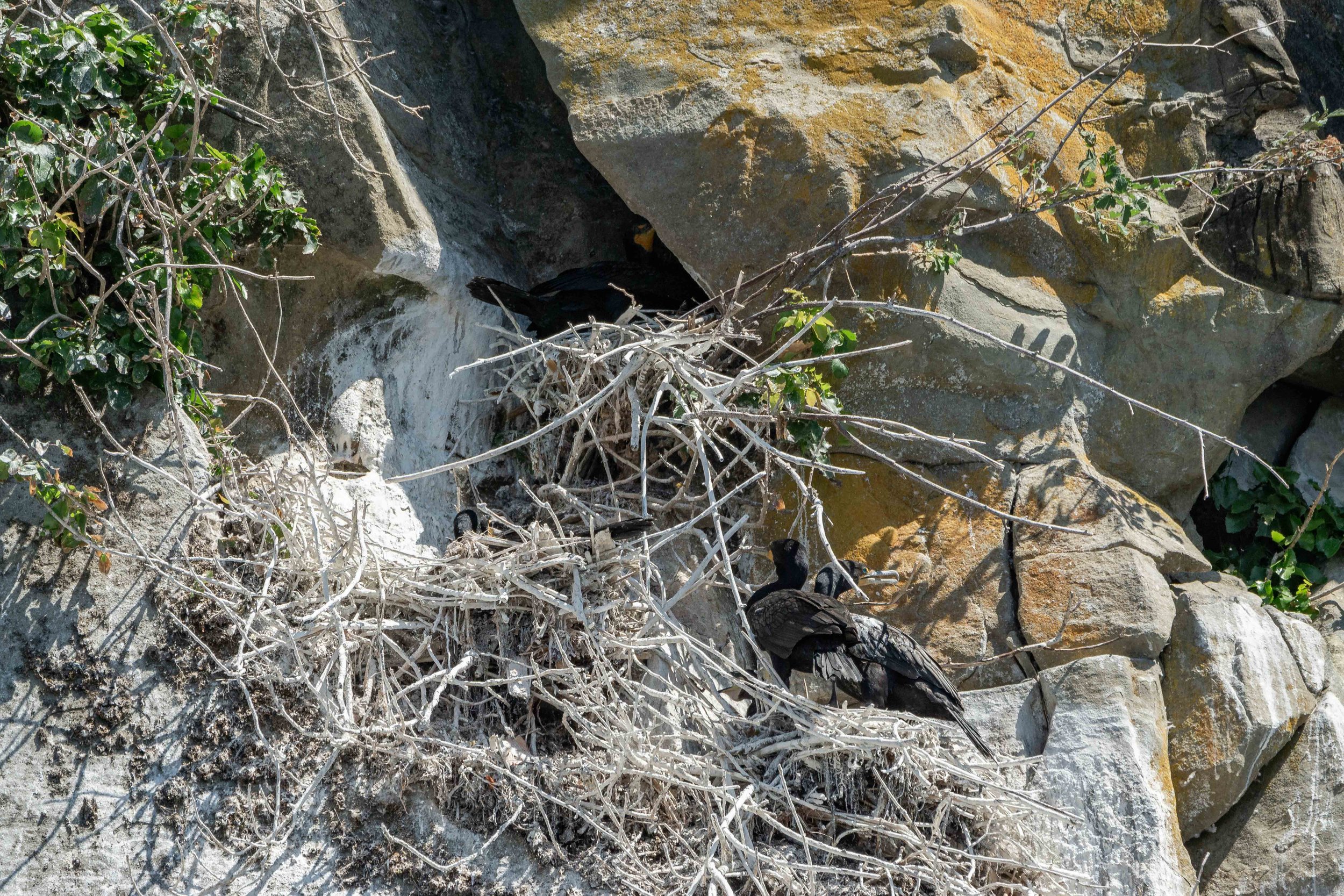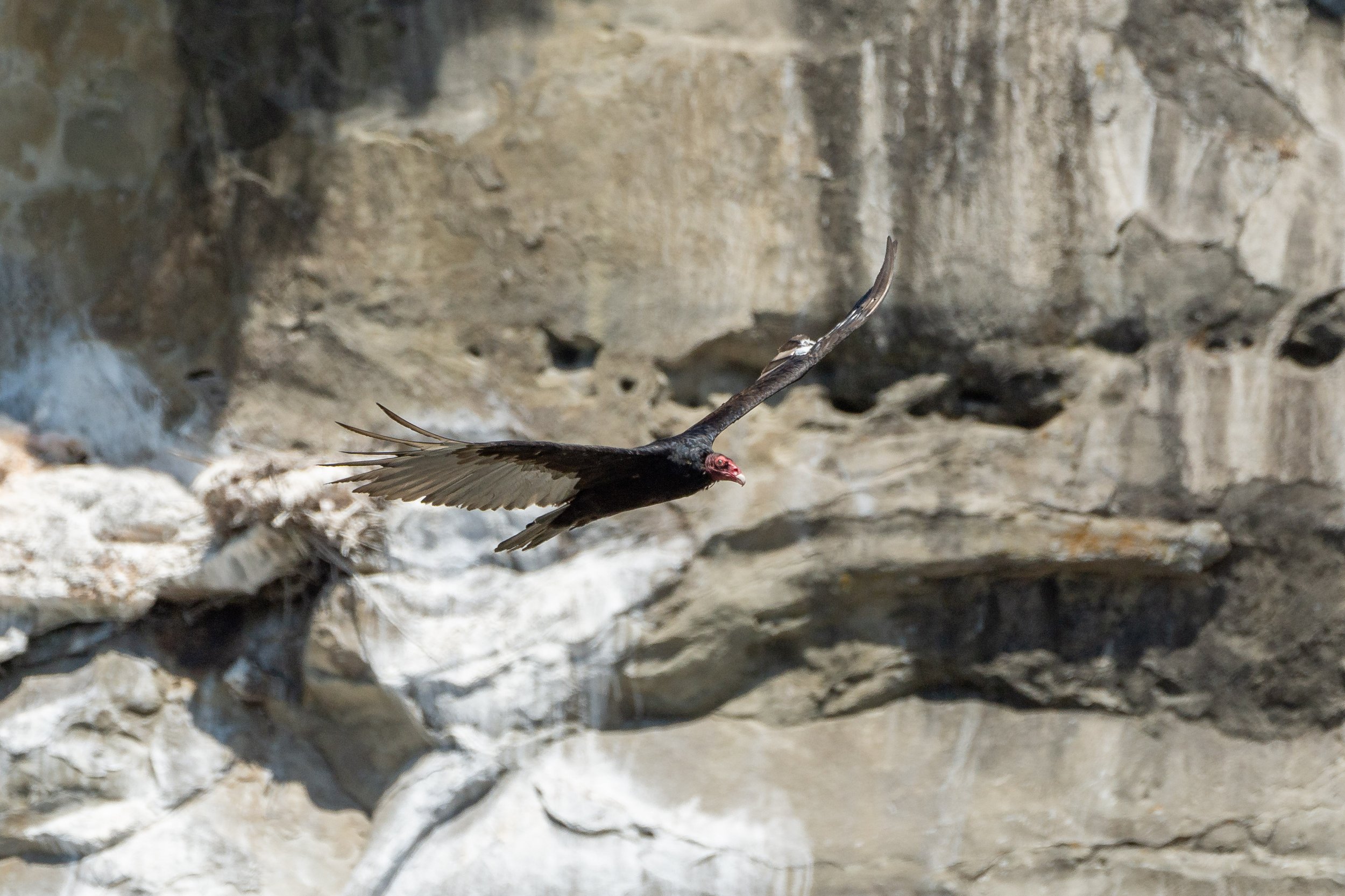July 19, 2024, 10:30 AM - Three pairs of Humpbacks in the waves
It was a very sunny morning as we had all three of our vessels head out into the Salish Sea to find out what was in store for us today. Two of the boats headed over the north end of Gabriola Island, while the other headed south to search the inside waters before joining the others in the Strait of Georgia afterwards.
As we were searching for whales of our own, we got word that one of the boats based in Vancouver had found some not too far away, so we decided to head in that direction! Two of the boats headed right there, while the third made a pit stop at Stinky Rocks to see the pinnipeds that were spending time there.
With the whales, they were able to quickly ID one of the whales based on their very distinct dorsal fin while the other took a little longer. Although we also know this whale from a very distinct dorsal fin, it changed drastically in the last year, making it harder to match if you didn’t know about this change. Lucky for us they also fluked and showed off the underside of their tail for us to confirm two of the whales as Valiant (BCX1773) and Kelp Creature (KC, BCY0291)! These two were closely associating, as another two also travelled together not too far away. These other two were Coyote (BCX0837calf2021) and Incognito (BCX2053). Watching these whales, we noticed that one of them, KC, was very much covered in Whale Barnacles. These are barnacles similar to what you would find on a rocky shoreline, except that they are a different species. Most whales will have barnacles on them, but they would all be different species of barnacles! There are two species of barnacles found on the humpback whale, the acorn barnacles (the hard white ones) and the goose-necked barnacles (they look pink and fleshy). It’s thought that humpback whales will typically carry hundreds of pounds of barnacles on their body between these two species, about the weight equivalence of us wearing clothes. It was pretty exciting getting to watch these whales surfacing in the waves!
One of the whales (either Coyote or Incognito) got a little excited in the waves as we were spending time with them and did a little spy hop (where they lifted their face out of the water) and a cartwheel! It was amazing to see the whales with this little bit of extra energy. Soon it was time to leave them behind, and the two open boats continued back towards Gabriola Island and to the waters of the Southern Gulf Islands.
While the two open boats explored the inside, the semi-covered vessel decided to stay on the outside and head further north where they came across another pair of humpback whales travelling together. These whales were Graze (BCY0523) and Niagara (BCY0057). When we first found them, these whales were just travelling in the area, doing deep dives in search of food, but it seemed like they must have got their fill since one of them started being a little rambunctious at the surface, slapping their 5 meter long pectoral fins against the surface of the water! We aren’t exactly sure why the whales do this, but the leading theories are that it’s fun for the whales, it might be used to knock off parasites (like those barnacles we were talking about earlier) or it might be long-distance communication! We didn’t know why this whale did it today, but it was still great to watch. After their time with these two whales, Kula continued travelling back to Nanaimo.
While the others were on their whale adventure, one of our open boats inside the islands found a very cool spot. At the Rose Islets, a known haul-out spot for harbour seals, we saw a large congregation of Bald Eagles and Turkey Vultures on the rocks. We headed over there to see if there was a poor Harbour Seal that didn’t make it, and we were right, these birds were all taking care of what looked like the remains of a harbour seal pup on the beach. It was slightly sad, but it’s the circle of life, and it would’ve made a good meal for all these birds and their own young that they might be taking care of still.
After their solo adventures, all of the vessels made one final stop at the Gabriola Bluffs to see the Bald Eagles there, as well as the Cormorants that were nesting along the cliffs. Although wavy today it was packed full of wildlife with amazing experiences with all of them! Please enjoy the photos taken by the onboard marine naturalists Hayleigh Hilbert, Lucy Willis, and Val Watson that are below!
Valiant in the background and KC in the foreground. Photo by Val Watson.
Valiant surfacing in the waves. Photo by Val Watson.
Valiant’’s very distinct dorsal fin. Photo by Hayleigh Hilbert.
Incognito’s dorsal surface in the background, with Coyote lifting their tail in front! Photo by Hayleigh Hilbert.
The underside of Coyote’s tail flukes. Photo by Lucy Willis.
Coyote surfacing with Incognito just behind them. Photo by Hayleigh Hilbert.
Kelp Creature’s new dorsal fin. Photo by Hayleigh Hilbert.
Kelp Creature going for a dive. Photo by Hayleigh Hilbert.
These bumps on the rostrum are called tubercles! Photo by Lucy Willis.
Coyote in front and Incognito in the back. Photo by Lucy Willis.
A close pass from Coyote. Photo by Lucy Willis.
A brief look at the underside of Prowler’s tail fluke. Photo by Lucy Willis.
The underside of Valiant’s tail fluke. Photo by Val Watson.
See the white spot on Valiant’s dorsal fin. Photo by Val Watson.
The cute little harbour seals on Stinky Rocks. Photo by Lucy Willis.
A harbour Seal hanging out next to a purple Ochre Star. Photo by Val Watson.
This male Harbour Seal was feeling very relaxed on the rocks. Photo by Val Watson.
A baby harbour seal hanging out in the intertidal zone. Photo by Val Watson.
Two Steller Sea Lions watching us from the rocks. Photo by Val Watson.
A constellation of Sea Stars. Photo by Val Watson.
This poor Steller faceplanted on her way to the water. Photo by Val Watson.
In she goes. Photo by Val Watson.
Niagara swimming in the direction of the boat before diving. Photo by Hayleigh Hilbert.
Niagara lifting their tail flukes to dive. Photo by Hayleigh Hilbert.
The top of Niagara’s tail flukes. Photo by Hayleigh Hilbert.
Niagara’s pectoral fin. Photo by Hayleigh Hilbert.
Graze’s dorsal fin. Photo by Hayleigh Hilbert.
Graze creating a fluke waterfall as she dives. Photo by Hayleigh Hilbert.
Niagara’s dorsal fin. Photo by Hayleigh Hilbert.
Niagara’s dorsal fin. Photo by Hayleigh Hilbert.
The underside of Niagara’s tail. Photo by Hayleigh Hilbert.
Graze and Niagara driving side by side. Photo by Hayleigh Hilbert.
Niagara lifting their tail to dive. Photo by Hayleigh Hilbert.
Graze making a fluke waterfall. Photo by Hayleigh Hilbert.
Harbour Seals hauled out at Snake Island. Photo by Hayleigh Hilbert.
Cormorants drying off on the rocks. Photo by Hayleigh Hilbert.
Two bald eagles on the Rose Islets waiting for their turn at the meal. Photo by Val Watson.
Look at the bald eagle on the shelly beach. Photo by Val Watson.
A Turkey Vulture on the Rose Islets. Photo by Val Watson.
This bald eagle was eyeing us up as we floated watching them. Photo by Val Watson.
Gore Warning One Photo Below!
This is what all the birds were here for, a dead harbour seal. Photo by Val Watson.
A Black Oyster Catcher flying overhead. Photo by Val Watson.
This Bald Eagle was headed back over to the seal. Photo by Val Watson.
3.2 Black Oyster Catchers are in this photo! Photo by Val Watson.
Some Cormorants on the gabriola Bluffs. Photo by Val Watson.
A great look at their nests, covered in poop. Photo by Val Watson.
We spotted a Turkey Vulture soaring over us at the bluffs. Photo by Val Watson.
A look at the sandstone cliffs. Photo by Hayleigh Hilbert.
















































